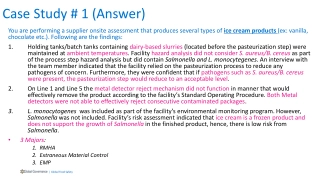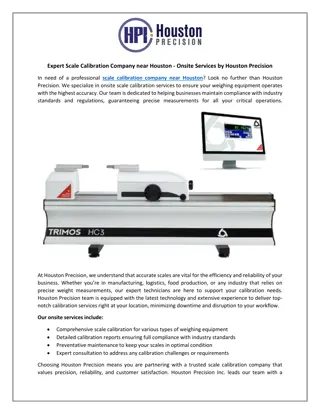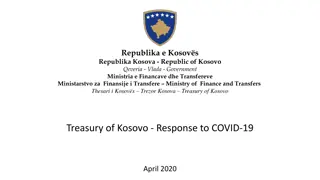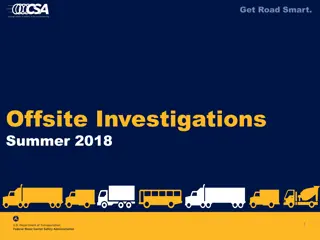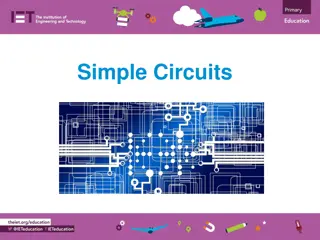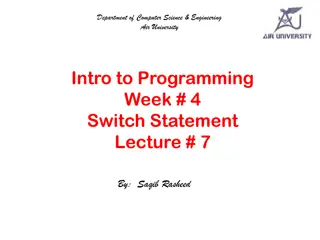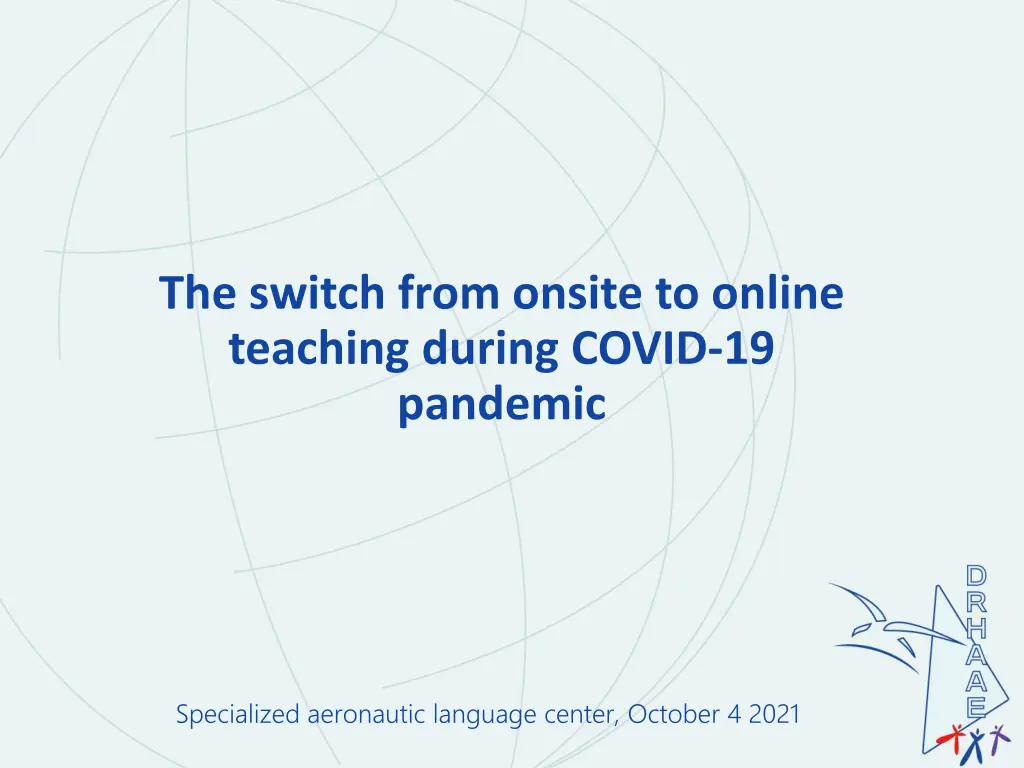
Navigating Online Teaching Challenges in Aeronautic Language Center
Explore the transition from onsite to online teaching at a specialized aeronautic language center during the COVID-19 pandemic, discussing the benefits, drawbacks, and solutions. Learn about the stages of military and academic training, specialized English training, and the objectives of the center. Discover the expertise of the Expert Center in Tours, France, and the teaching tools used, including specialized books and multimedia labs.
Download Presentation

Please find below an Image/Link to download the presentation.
The content on the website is provided AS IS for your information and personal use only. It may not be sold, licensed, or shared on other websites without obtaining consent from the author. If you encounter any issues during the download, it is possible that the publisher has removed the file from their server.
You are allowed to download the files provided on this website for personal or commercial use, subject to the condition that they are used lawfully. All files are the property of their respective owners.
The content on the website is provided AS IS for your information and personal use only. It may not be sold, licensed, or shared on other websites without obtaining consent from the author.
E N D
Presentation Transcript
The switch from onsite to online teaching during COVID-19 pandemic Specialized aeronautic language center, October 4 2021
The switch from onsite to online teaching during COVID-19 pandemic
The switch from onsite to online teaching during COVID-19 pandemic Introduction/ missions of the center Benefits of online teaching Drawbacks of online teaching / Solutions ? Conclusion
Stage 1 Stage 2 Stage 3 Basic military / academic training Specialty / occupational training continuous training Who? Military trainees (cadets, NCOs) Who? Air Force specialist trainees Who? All Air Force personnel What? General English training What? Specialized English training What? English training throughout the career Where? In FAF Academy and NCO school Where? In branch school centers Where? - Specialized Center - 13 local English trainingcenters Objective? Make enough in general English to take specialized English courses Aeronautic Language Objective? Provide trainees with the English-language skills required in professional fields sure trainees are proficient their respective Objective? Help personnel keep up and improve proficiency in professional English
EXPERT CENTER Specialized Aeronautic Language Centre (CLAS), in Tours, France. Expertise in all fields of professional English related to the aeronautic environment: English for pilots, air traffic controllers, aircraft mechanics and technicians , etc. Other areas of military interest: meteorology, telecommunications, English for external operations etc. English teacher training
TEACHING TOOLS Specialized books and dictionaries (Aviation English, Campaign, English for Aircraft, technical documentation on specific aircraft ) Multimedia labs (pronunciation / listening / placement tests ) and feedback from multinational military operations participants
The switch from onsite to online teaching during COVID-19 pandemic
The switch from onsite to online teaching during COVID-19 pandemic
The switch from onsite to online teaching during COVID-19 pandemic 1. What are the benefits of teaching online ? We could ensure continuity in our teaching. During the different lockdowns, remote teaching allowed us to continue delivering classes to our trainees from our homes. We managed to keep a link with our trainees and make them progress in their learning of English. BUT we were NOT prepared at all to teach online !!!
The switch from onsite to online teaching during COVID-19 pandemic What was the solution ahead of us ? scan the web for free digital tools Tools for videoconference : Big Blue Button, Zoom, Discord, Skype, Whatsapp Tools for sharing our pedagogical materials : Padlet, any Drive (to save the files for our trainees), useful for homework. Our learners could have much more resources at their disposal. But they had to be directed in their learning. We managed to do that thanks to the different digital tools for videoconference I mentioned beforehand BBB for example : free but some limitations !!!
The switch from onsite to online teaching during COVID-19 pandemic BBB was victim of its success : lots of issues in terms of connectivity for instance. With Discord, we could create private servers we could customize to act as a virtual classroom where we can share pedagogical content and hold meetings. But again we experienced connectivity issues !!! We had to switch from video calls to voice calls. We managed to teach our trainees by simply using Skype or Whatsapp. Padlet : It is a digital pinboard that allows participants (trainees and teachers) to contribute by pinning different images, videos, text files, links, and more.
The switch from onsite to online teaching during COVID-19 pandemic Here are some examples of our Padlet boards : - https://padlet.com/pascal_proust/vghgl7i6xqbq5i0c (FCL) - https://padlet.com/pascal_proust/nj61biilmq4gxj2u (ADEPT-4C) - https://padlet.com/pascal_proust/ty33e0ip2z18vrmy (AVIONICS) Some technical training courses worked well with the free digital tools that we found but some others were quite difficult to implement online because of the connectivity issues : for example it was quite hard to do debate activities as the videos sometime froze or the teacher could not hear what was said by the trainees
The switch from onsite to online teaching during COVID-19 pandemic 2. What are the drawbacks when teaching online? From the teacher s view : - Connectivity issues, inequality on bandwidth capacity - Usual group activities are very hard to implement online - Teaching online is tiring but stimulating - Lack of knowledge on the digital tools - There s a digital divide among the trainees (younger generation trainees are more savvy with new technologies). - Having to explain to trainees how the tool works again and again is a loss of time - Anything done online suffers from attention span, because students also do something else while attending online lessons We should not forget that some of them have small children around too
The switch from onsite to online teaching during COVID-19 pandemic How did we manage to offer a solution accessible to all ? We had to adopt a contact process for the teachers and we chose to email our trainees : 1. The teachers e-mailed the instructions to the group 2. informed the students about the tool that they would use. 3. gave the timetable for students to connect at the correct time. 4. told students that homework would be given for self-directed work. 5. gave a tutorial of the tool. At last, what we retained was to combine a digital tool for videoconference (BBB, Discord or even Skype would do the job) with a tool aimed at sharing files (Padlet, Google Docs etc )
The switch from onsite to online teaching during COVID-19 pandemic As a backup, we created a whatsapp group in order to handle connectivity issues and switch to a phone call. A two-hour session in the morning and a two-hour session in the afternoon are the limits we should not go beyond As director of studies, I am in charge of the students feedback and I could most of the time lead a live feedback session (15 minutes) at the end of the training course. For those I could not do live, I sent a written questionnaire to the students. From the students side: - FCL training course requires self-directed work. I appreciated to have the correction of the listening exercises - Skype and Google Drive are very good tools - BBB is a very good tool even if we had some connectivity issues - We used Skype. I received some exercises to do as homework. It was easy to use. - We used Padlet, a tool that is well adapted to teaching English online. - Sometimes, some files were impossible to open
The switch from onsite to online teaching during COVID-19 pandemic What we have learned .you can t just replicate what you do in real life But, we do think that there is a value to hosting live classes And then we could give the rest of the materials to students for self- directed work. What is most important is to promote participation from the trainees !!!
The switch from onsite to online teaching during COVID-19 pandemic To conclude, I would say that switching from onsite teaching to remote courses was not plain sailing. We completely had to start from scratch Delivering classes at short notice to learners who are sometimes skeptical of the value/quality of teaching you might provide was somehow quite challenging for my team. We have today moved back to our physical classrooms But the lesson to be learned from this crisis is that we definitely have to work more on digital classes in the future and include blended learning in the training courses we offer !


